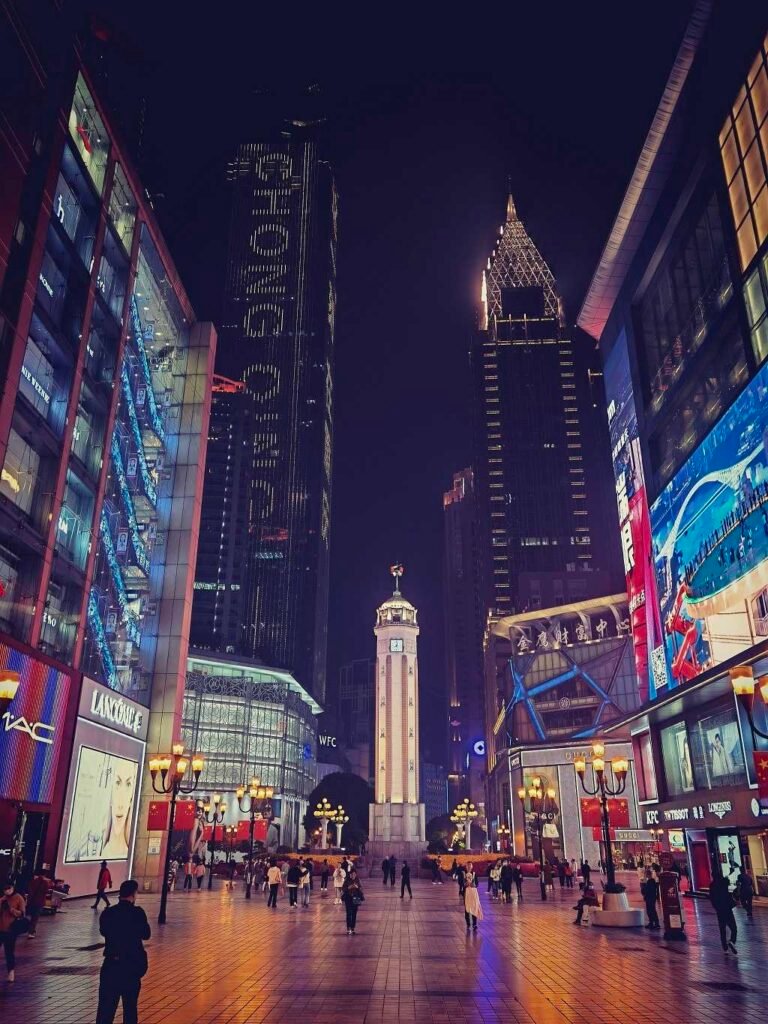I. Dual Identity: Historical Landmark & Modern Commercial Hub
- Historical Symbol
- From Wartime Resilience to Liberation:
The Liberation Monument was first built in 1940 as the “Spiritual Fortress” to inspire Chinese resistance during the Second Sino-Japanese War. In 1947, it was rebuilt as the “Monument to the Victory in the War of Resistance Against Japan” (China’s only monument dedicated to this victory). Renamed “People’s Liberation Monument” in 1950 by General Liu Bocheng, it symbolizes Chongqing’s liberation and the founding of New China. - Architectural Details:
Standing 27.5 meters tall with an octagonal pillar design, the monument features a self-ringing clock at its top and a spiral staircase leading to an observation deck. Underground chambers preserve historical artifacts, including soldier casualty lists and replicas of letters from President Roosevelt to Chongqing.
- From Wartime Resilience to Liberation:
- Commercial Center Status
- Economic Engine:
The Liberation Monument (shopping district) is Chongqing’s first commercial zone to exceed ¥50 billion in annual retail sales. It hosts 15 major malls (e.g., Times Square, Guotai Plaza) covering 2.62 million m², with 100+ international brands like LV and Gucci, earning it the title “Golden Cross Street”. - 24/7 Vibrancy:
By day, it’s a shopping paradise; by night, neon lights illuminate 24-hour hotpot restaurants, bars, and night markets showcasing the city’s lively spirit.
- Economic Engine:

II. Shopping & Food: Global Trends & Local Flavors
- Shopping Guide
- Luxury: Times Square (international luxury brands), Yingli D.R.C. (designer boutiques).
- Local Souvenirs: Buy hotpot base kits, Jiangjin Rice Candy, and Shu embroidery crafts at street shops.
- Must-Try Foods CategoryTop StoresSignature DishesHotpotPeijie Old HotpotNine-grid spicy hotpot with crispy tripe & duck intestineChongqing NoodlesHuashi Wanza NoodlesSpicy noodles with soft peas & meat sauceLocal CuisineYangji LongfuCrispy Spicy Chicken paired with ice jelly dessert
III. Cultural Experiences: Wartime Legacy to Urban Art
- Historical Traces
- Wartime Memory: Reliefs and five-pointed stars on the monument symbolize national unity. White chrysanthemums are often placed at its base to honor war heroes.
- New Year Tradition: On December 31, crowds gather for the bell-ringing ceremony. In 2008, 180,000 attendees set a Guinness World Record.
- Modern Culture Fusion
- Art Spaces: Chongqing Art Museum and Guotai Art Center host exhibitions blending Sichuan opera with modern dance.
- Film Landmarks: Movie sites from Chongqing Hot Pot (2016) and The Captain (2019) attract photo seekers.
IV. Efficient Routes & Practical Tips
▎One-Day Highlights Route
- Morning: Photos at Liberation Monument (avoid crowds) → Breakfast at Bayi Road Snack Street (spicy noodles + sweet dumplings) → Nostalgic shopping at Chongqing Department Store.
- Afternoon: Visit Korean Provisional Government Site (5-min walk) → Ride Yangtze River Cableway for river views.
- Night: Hongya Cave light show (10-min walk) → Return for bars or night-market skewers.
▎Key Info
| Category | Details |
|---|---|
| Transport | Light Rail Lines 1/6 (Xiaoshizi Station Exit 5A), Line 2 (Linjiangmen Station); Bus 462/465 to “Jiefangbei” |
| Ticket | Free entry, open 24/7 |
| Best Time | Weekdays (avoid crowds); New Year’s Eve/Spring Festival for special events |
| Safety | Guard valuables in crowds; sunscreen & hydration essential in summer |
V. Why the Liberation Monument is Irreplaceable
The monument is a convergence of time and space—touching bricks scarred by 1940s bombings with one hand while reaching for global fashion displays with the other. It embodies Chongqing’s spirit: honoring the resilience of Sichuan soldiers who defended the nation while pulsing with modern China’s consumer energy. When tourists tear up from Peijie Hotpot’s spice or embrace strangers under New Year’s Eve bells, the monument transcends tourism, becoming an emotional bridge between past and present.
Traveler’s Note: Don’t just snap a photo. Visit at 7 AM to watch tai chi reflections dance on Gucci’s glass facade; return at midnight to smell barbecue smoke mingle with office-tower lights—this is the real breath of a Chinese megacity.
Bookmark our website, and we will provide you with more travel guides for China.




















